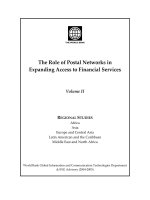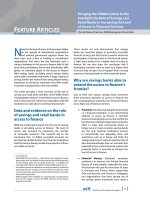AWS USER GUIDE TO FINANCIAL SERVICES REGULATIONS IN BRAZIL – CENTRAL BANK OF BRAZIL, RESOLUTION 4,89321 AND RESOLUTION 8521 UPDATED MARCH 2023 FIRST PUBLISHED JULY 2018
Bạn đang xem bản rút gọn của tài liệu. Xem và tải ngay bản đầy đủ của tài liệu tại đây (516.72 KB, 24 trang )
AWS User Guide to Financial Services
Regulations in Brazil – Central Bank of
Brazil, Resolution 4,893/21 and
Resolution 85/21
Updated March 2023
First Published July 2018
Notices
Customers are responsible for making their own independent assessment of the information in this
document. This document: (a) is for informational purposes only, (b) represents current AWS product
offerings and practices, which are subject to change without notice, and (c) does not create any
commitments or assurances from AWS and its affiliates, suppliers or licensors. AWS products or services
are provided “as is” without warranties, representations, or conditions of any kind, whether express or
implied. The responsibilities and liabilities of AWS to its customers are controlled by AWS agreements,
and this document is not part of, nor does it modify, any agreement between AWS and its customers.
© 2023 Amazon Web Services, Inc. or its affiliates. All rights reserved.
Contents
Introduction .................................................................................................................................................. 1
Security in the cloud.................................................................................................................................. 2
Security of the cloud ................................................................................................................................. 3
AWS Compliance Assurance Programs ......................................................................................................... 4
Certifications and third-party attestations ............................................................................................... 4
AWS Artifact.............................................................................................................................................. 5
AWS Global Infrastructure ............................................................................................................................ 6
The BCB Resolutions ..................................................................................................................................... 6
Implementing a cybersecurity policy ........................................................................................................ 7
Implementing an action plan and incident response plan ..................................................................... 11
Hiring of cloud computing services......................................................................................................... 11
Agreements with cloud service providers............................................................................................... 17
Business continuity plan ......................................................................................................................... 17
Notification requirement ........................................................................................................................ 17
Next steps ................................................................................................................................................... 19
Additional resources ................................................................................................................................... 20
Document history ....................................................................................................................................... 20
About this guide
This AWS User Guide to Financial Services Regulations in Brazil provides information to assist financial
institutions regulated by the Central Bank of Brazil as they accelerate their use of Amazon Web Services
(AWS) cloud services.
This guide provides the following information:
• A Description of the respective roles that financial and payment institutions and AWS each play
in managing and securing the cloud environment.
• An Overview of the regulatory requirements and guidance that financial institutions can
consider when using AWS.
• Additional resources that financial institutions can use to help them architect and operate their
AWS environment to meet regulatory expectations, including under the Central Bank of Brazil’s
regulations.
Amazon Web Services AWS User Guide to Financial Services Regulations in Brazil
Introduction
The National Monetary Council––Conselho Monetário Nacional (CMN)––is the main institution
responsible for monetary and credit policy within Brazil’s financial system. The Central Bank of Brazil––
Banco Central do Brasil (BCB)––is one of the supervisory authorities linked to CMN responsible for
ensuring compliance with the CMN regulations and for the maintenance, regulation, monitoring, and
supervision of the financial institutions under its jurisdiction.
On February 26, 2021, BCB issued Resolution No. 4,893 on cybersecurity policy and the requirements
for contracting data processing storage and cloud computing services to be complied by financial and
other institutions authorized to operate by BCB. In addition, Resolution No. 4,893 revoked and replaced
Resolution No. 4,658, issued on April 26, 2018, and Resolution No. 4,752, issued on September 26, 2019.
On April 08, 2021, BCB further issued Resolution No. 85 on cybersecurity policy and the requirements
for contracting data processing storage and cloud computing services to be complied by payment
institutions. Resolution No. 85 replaced Resolution No. 3,909, issued on August 16, 2018, and Resolution
No. 3,969, issued on November 13, 2019.
Resolution No. 4,893 and Resolution No. 85 (together, the BCB Resolutions) articulate and consolidate
the steps that financial and payment institutions (Regulated Institutions) are required to take to manage
cybersecurity risks in connection with their use of cloud services. The BCB Resolutions require Regulated
Institutions to evaluate cloud providers and set up internal controls to manage the relationship with the
cloud provider. In so doing, the BCB Resolutions outline a path that Regulated Institutions can follow to
use the cloud in a safe and resilient manner.
This guide is intended to be a resource to help Regulated Institutions navigate the requirements of the
BCB Resolutions in the context of their cloud adoption. The following sections provide considerations for
Regulated Institutions as they assess their responsibilities with regards to the BCB Resolutions. This
guide does not cover every provision of the regulations, nor does it address other compliance or legal
requirements that may apply to AWS customers. As customers’ compliance needs differ, AWS
encourages its customers to obtain their own independent assessment on relevant compliance
requirements that may be applicable to their business.
Security and the Shared Responsibility Model
Before exploring the specific requirements outlined in the BCB Resolutions, it is important for Regulated
Institutions to understand the Shared Responsibility Model. The Shared Responsibility Model is
fundamental to understanding the respective roles of customers and AWS in the operation and
management of security in the context of the BCB Resolutions.
Compliance and security are a shared responsibility between customer and AWS. AWS manages security
of the cloud by protecting the infrastructure that runs all of the services offered in the AWS Cloud,
including operating, managing and controlling IT components from the host operating system and
1
Amazon Web Services AWS User Guide to Financial Services Regulations in Brazil
virtualization layer down to the physical security of the facilities in which the services operate, while
customers are responsible for the security in the cloud. This means that customers retain control of the
security programs that they choose to implement to protect their content, applications, systems, and
networks, as they would for applications in an on-premises data center.
Figure 1: Shared responsibility model
Security in the cloud
Customers are responsible for their security in the cloud. AWS customers are responsible for managing
the guest operating system, which includes installing updates and security patches and other associated
application software, as well as any applicable network security controls.
The customer generally connects to the AWS environment through services the customer acquires from
third parties (for example, internet service providers). AWS does not provide these connections; they
are part of the customer’s area of responsibility. Customers should consider the security of these
connections and the security responsibilities of such third parties in relation to their systems.
Customers should carefully consider the services they choose because their responsibilities vary
depending on the services they use, the integration of those services into their IT environments, and
applicable laws and regulations. It is important to note that when using AWS services, customers
maintain control over their content and are responsible for managing critical content security
requirements, including the following:
• The content that they choose to store on AWS.
• The AWS services that they use with the content.
2
Amazon Web Services AWS User Guide to Financial Services Regulations in Brazil
• The country where they store their content.
• The format and structure of their content and whether it is masked,
anonymized, or encrypted.
• The way they encrypt their data and where they store their keys.
• Who has access to their content and how those access rights are granted,
managed, and revoked.
Because customers, rather than AWS, control these important factors, customers retain responsibility
for their choices. Customer responsibility is determined by the AWS Cloud services that a customer
selects. This selection, in turn, determines the amount of configuration work the customer must
perform as part of their security responsibilities. For example, a service such as Amazon Elastic Compute
Cloud (Amazon EC2) is categorized as infrastructure as a service (IaaS) and, as such, requires the
customer to perform all of the necessary security configuration and management tasks.
Customers that deploy an Amazon EC2 instance are responsible for management of the guest operating
system (including updates and security patches), any application software or utilities installed by the
customer on the instances, and the configuration of the AWS provided firewall (called a security group)
on each instance.
For abstracted services, such as Amazon Simple Storage Service (Amazon S3) and Amazon DynamoDB,
AWS operates the infrastructure layer, the operating system, and platforms, and customers access the
endpoints to store and retrieve data. Customers are responsible for managing their data (including
encryption options), classifying their assets, and using Identity and Access Management (IAM) tools to
apply the appropriate permissions.
Security of the cloud
AWS is responsible for protecting the infrastructure that runs all of the services offered in the AWS
Cloud. This infrastructure is composed of the hardware, software, networking, and facilities that run
AWS Cloud services. Customers can use AWS compliance certifications to validate the implementation
and effectiveness of AWS security controls, including internationally recognized security best practices
and certifications.
The AWS compliance program is based on the following:
• Validating that AWS services and facilities across the globe maintain a ubiquitous control
environment that is operating effectively. The AWS control environment encompasses the
people, processes, and technology necessary to establish and maintain an environment that
supports the operating effectiveness of the AWS control framework. AWS has integrated
applicable cloud-specific controls identified by leading cloud computing industry bodies into the
AWS control framework. AWS monitors these industry groups to identify leading practices that
customers can implement and to better assist customers with managing their control
environment.
3
Amazon Web Services AWS User Guide to Financial Services Regulations in Brazil
• Demonstrating the AWS compliance posture to help customers verify compliance with industry
and government requirements. AWS engages with external certifying bodies and independent
auditors to provide customers with information regarding the policies, processes, and controls
established and operated by AWS. Customers can use this information to perform their control
evaluation and verification procedures, as required under the applicable compliance standard.
• Monitoring, through applicable security controls, that AWS maintains compliance with global
standards and best practices.
AWS Compliance Assurance Programs
AWS has obtained certifications and third-party attestations for a variety of industry-specific workloads.
AWS has also developed compliance programs to make these resources available to customers.
Customers can use the AWS compliance programs to help satisfy their regulatory requirements. For
more information about these third-party certifications and audit reports, see AWS Compliance
Programs.
Certifications and third-party attestations
AWS has obtained certifications and independent third-party attestations for a variety of industry
specific workloads; however, the following are particularly important for Regulated Institutions:
ISO 27001 – ISO 27001 is a security management standard that specifies security management best
practices and comprehensive security controls following the ISO 27002 best practice guidance. The basis
of this certification is the development and implementation of a rigorous security program, which
includes the development and implementation of an information security management system that
defines how AWS perpetually manages security in a holistic, comprehensive manner.
ISO 27017 – ISO 27017 provides guidance on the information security aspects of cloud computing,
recommending the implementation of cloud-specific information security controls that supplement the
guidance of the ISO 27002 and ISO 27001 standards. This code of practice provides additional
information security controls implementation guidance specific to cloud service providers.
ISO 27018 – ISO 27018 is a code of practice that focuses on protection of personal data in the cloud. It is
based on ISO information security standard 27002 and provides implementation guidance on ISO 27002
controls applicable to public cloud personally identifiable information (PII). It also provides a set of
additional controls and associated guidance intended to address public cloud PII protection
requirements not addressed by the existing ISO 27002 control set.
ISO 9001 – ISO 9001 outlines a process-oriented approach to documenting and reviewing the structure,
responsibilities, and procedures required to achieve effective quality management within an
organization. The key to the ongoing certification under this standard is establishing, maintaining, and
improving the organizational structure, responsibilities, procedures, processes, and resources in a
manner in which AWS products and services consistently satisfy ISO 9001 quality requirements.
4
Amazon Web Services AWS User Guide to Financial Services Regulations in Brazil
PCI DSS Level 1 – The Payment Card Industry Data Security Standard (also known as PCI DSS) is a
proprietary information security standard administered by the PCI Security Standards Council. PCI DSS
applies to all entities that store, process, or transmit cardholder data (CHD) or sensitive authentication
data (SAD) including merchants, processors, acquirers, issuers, and service providers. The PCI DSS is
mandated by the card brands and administered by the Payment Card Industry Security Standards
Council. For more information or to request the PCI DSS Attestation of Compliance and Responsibility
Summary, see PCI DSS Compliance.
SOC – AWS System and Organization Controls (SOC) Reports are independent third-party examination
reports that demonstrate how AWS achieves key compliance controls and objectives. The purpose of
these reports is to help customers and their auditors understand the AWS controls established to
support operations and compliance. There are three types of AWS SOC Reports:
• SOC 1 – Provides information about the AWS control environment that may be relevant to a
customer’s internal controls over financial reporting and information for assessment and
opinion of the effectiveness of internal controls over financial reporting (ICOFR).
• SOC 2 – Provides customers and their service users with a business need with an independent
assessment of the AWS control environment relevant to system security, availability, and
confidentiality.
• SOC 3 – Provides customers and their service users with a business need with an independent
assessment of the AWS control environment relevant to system security, availability, and
confidentiality without disclosing AWS internal information.
By tying together governance-focused, audit-friendly service features with such certifications,
attestations and audit standards, AWS Compliance enablers build on traditional programs. This helps
customers to establish and operate in an AWS security control environment.
For more information about other AWS certifications, reports, and attestations, see AWS Compliance
Programs. For information about general AWS security controls and service-specific security, see Best
Practices for Security, Identity, & Compliance.
AWS Artifact
Customers can review and download reports and details about more than 2,600 security controls using
AWS Artifact, the automated compliance reporting portal available in the AWS Management Console.
The AWS Artifact portal provides on-demand access to AWS security and compliance documents,
including Service Organization Control (SOC) reports, Payment Card Industry (PCI) reports and
certifications from accrediting bodies across geographies and compliance verticals that validate the
implementation and operating effectiveness of AWS security controls.
5
Amazon Web Services AWS User Guide to Financial Services Regulations in Brazil
AWS Global Infrastructure
The AWS Global Cloud infrastructure comprises AWS Regions and Availability Zones. A Region is a
physical location in the world that consist of multiple Availability Zones. Availability Zones consist of one
or more discrete data centers, each with redundant power, networking, and connectivity, all housed in
separate facilities. These Availability Zones offer customers the ability to operate applications and
databases, which are more highly available, fault tolerant, and scalable than would be possible in a
traditional, on-premises environment. Customers can learn more about these topics by downloading our
whitepaper on Amazon Web Services’ Approach to Operational Resilience in the Financial Sector
& Beyond.
AWS customers choose the AWS Regions in which their content and servers are located. This allows
customers to establish environments that meet specific geographic or regulatory requirements.
Additionally, this allows customers with business continuity and disaster recovery objectives to establish
primary and backup environments in a location or locations of their choice. More information on our
disaster recovery recommendations is available at Disaster Recovery of Workloads on AWS:
Recovery in the Cloud.
For example, AWS customers in Brazil can choose to deploy their AWS services exclusively in the South
America (São Paulo) Region and store their content onshore in Brazil, if this is their preferred location. If
the customer makes this choice, their content will be located in Brazil unless the customer chooses to
move that content.
The AWS South America (São Paulo) Region is designed and built to meet rigorous compliance standards
globally, providing high levels of security for all AWS customers. As with every AWS Region, the South
America (São Paulo) Region is compliant with applicable national and global data protection laws.
The BCB Resolutions
The BCB Resolutions require Regulated Institutions to adopt a cybersecurity policy that addresses a wide
range of cybersecurity issues that include the use of service providers for data processing, data storage,
and cloud computing.
The BCB Resolutions also require Regulated Institutions to implement and maintain a cybersecurity
policy to ensure the confidentiality, integrity, and availability of data consistent with the materiality,
size, sensitivity of the data, risk profile, and business model of the services that the Regulated Institution
is running in the cloud. The BCB Resolutions identify several features that Regulated Institutions should
consider when evaluating a cloud provider.
A full analysis of the BCB Resolutions is beyond the scope of this guide. The following sections focus on
some of the key requirements contemplated in the BCB Resolutions and describe how Regulated
Institutions can use AWS services to help them meet these requirements.
6
Amazon Web Services AWS User Guide to Financial Services Regulations in Brazil
Implementing a cybersecurity policy
AWS services and the AWS Global Cloud Infrastructure can help Regulated Institutions build secure,
high-performing, resilient, and efficient infrastructure for their applications. World-class security experts
who monitor AWS infrastructure also build and maintain our broad selection of innovative security
services, which can help Regulated Institutions simplify meeting security and regulatory requirements.
AWS services are designed to be secure by default. Regulated Institutions can use AWS services and
solutions to implement an optimal security posture: Prevent, Detect, Respond, and Recover.
Below are some requirements from the BCB Resolutions framework and information on how Regulated
Institutions can use AWS services and solutions to help satisfy the requirements described in the
following table.
7
Amazon Web Services AWS User Guide to Financial Services Regulations in Brazil
BCB Resolutions Requirement Summary AWS Considerations
Chapter II, Section I, article 2 The AWS Cloud infrastructure has been architected to be the most flexible and secure cloud computing
environment available. The scale of AWS allows significantly more investment in security policing and
The institution shall implement and maintain a countermeasures than almost any large company could afford on its own. This infrastructure is composed
cybersecurity policy based on principles and of the hardware, software, networking, and facilities that run AWS services, which provide powerful
guidelines designed to ensure confidentiality, controls to customers. These include security configuration controls for handling sensitive data such as
integrity, and availability for data and information about financial transactions. AWS helps customers protect against cyber-attacks by providing a
information systems used. number of tools to secure their data. For a list of AWS resources and tools, refer to Security, Identity, and
Compliance on AWS.
AWS supports TLS/SSL encryption for all its API endpoints and the ability to create VPN tunnels to protect
data in transit. AWS also provides the AWS Key Management Service (AWS KMS) and dedicated Hardware
Security Module appliances for customers to encrypt data at rest. Customers can choose to secure their
data using the AWS provided capabilities or use their own security tools.
Chapter II, Section I, article 3.II Customers can use a number of AWS tools to help design secure architectures and reduce their
vulnerability to incidents. One key tool is Amazon Inspector, an automated vulnerability management
The Regulated Institution’s cybersecurity policy service that continually scans AWS workloads for software vulnerabilities and unintended network
shall contemplate, among other things, the exposure. After performing an assessment, Amazon Inspector produces a detailed list of security findings
internal procedures and controls adopted by prioritized by level of severity. These findings can be reviewed directly or as part of detailed assessment
the Regulated Institution to reduce its reports which are available on the Amazon Inspector console or API.
vulnerability to incidents and address other
cybersecurity objectives. Financial institutions can also use AWS services to perform penetration testing and simulated event testing.
For more information, see Penetration Testing.
Chapter II, Section I, article 3.III AWS offers customers many tools for governance and data traceability. AWS CloudTrail is a service that
enables governance, compliance, operational auditing, and risk auditing of AWS accounts. With CloudTrail,
The Regulated Institution’s cybersecurity policy customers can log, continuously monitor, and retain account activity related to actions across AWS
shall contemplate, among other things, the accounts. CloudTrail provides event history of AWS account activity. This includes actions taken through the
specific controls, including those used to AWS Management Console, AWS SDKs, command line tools, and other AWS services. This event history
ensure data traceability in order to secure simplifies security analysis, resource change tracking, and troubleshooting.
sensitive information.
8
Amazon Web Services AWS User Guide to Financial Services Regulations in Brazil
BCB Resolutions Requirement Summary AWS Considerations
Chapter II, Section I, article 3.V(c) AWS provides ways to categorize data based on levels of sensitivity. By using resource tags, IAM policies,
and Amazon Macie, customers can define and implement policies for data classification.
The Regulated Institution’s cybersecurity policy
shall contemplate, among other things, the
guidelines for classifying data and information
by its materiality.
This Section Purposely Left Blank
9
Amazon Web Services AWS User Guide to Financial Services Regulations in Brazil
10
Amazon Web Services AWS User Guide to Financial Services Regulations in Brazil
Implementing an action plan and incident response plan
Chapter II, Section III of the BCB Resolutions require Regulated Institutions to have in place cybersecurity
action plans and incident response procedures. AWS has implemented a formal, documented incident
response policy and program to respond to potential security threats in accordance with the Shared
Responsibility Model. AWS employs automated mechanisms to facilitate the monitoring and control of
remote access methods. Auditing occurs on the systems and devices, and information is then
aggregated and stored in a proprietary tool for review and incident investigation. All remote
administrative access attempts are logged and limited to a specific number of attempts. Auditing logs
are reviewed by the AWS Security team for unauthorized attempts or suspicious activity. In the event
that suspicious activity is detected, the incident response procedures are initiated. This information can
be reviewed in the AWS SOC 2 report, which is available to customers under a non-disclosure
agreement. For more information, please see the AWS Artifact section of this document.
Under the Shared Responsibility Model, AWS customers are responsible for establishing and
documenting usage restrictions, configuration and connection requirements, and implementation
guidance for each type of remote access allowed to their systems (including multi-factor authentication)
in accordance with their access control policy. AWS customers are responsible for authorizing remote
access to their systems prior to allowing such connections.
Regulated Institutions can use tools such as AWS CloudTrail, Amazon CloudWatch, AWS Config, Amazon
GuardDuty, and AWS Security Hub to track, monitor, analyze, and audit events. If these tools identify an
event that is analyzed and determined to be an incident, that qualifying event should raise an incident
and trigger the incident management process and any appropriate response actions by the Regulated
Institution that are necessary to mitigate the incident.
AWS also maintains public notification security bulletins, available in the AWS Security Center. For more
details on the measures AWS puts in place to maintain consistently high levels of security, see Best
Practices for Security, Identity, & Compliance.
Hiring of cloud computing services
Chapter III of the BCB Resolutions require Regulated Institutions to have risk management policies,
strategies, and structures in place that include criteria for using a cloud services provider. The BCB
Resolutions set out specific criteria that Regulated Institutions must contemplate in their risk
management policies and procedures for using a cloud service provider. The BCB Resolutions specifically
state that Regulated Institutions are expected to adopt corporate governance and management
practices with respect to outsourcing to service providers proportional to the materiality of the services
to be hired and the Regulated Institution’s risk exposure.
A Regulated Institution can use AWS services to assist in their compliance with the requirements
established in the BCB Resolutions. Some of these requirements are summarized in the following table.
11
Amazon Web Services AWS User Guide to Financial Services Regulations in Brazil
This Section Purposely Left Blank
12
Amazon Web Services AWS User Guide to Financial Services Regulations in Brazil
BCB Resolutions Requirement Summary AWS Considerations
Chapter III, Article 12 (II)
The Regulated Institution’s risk management policies and procedures should contemplate the examination of the potential ability of the potential service
provider to ensure:
(a) Compliance with legislation and regulation in AWS customers can validate the security controls in place within the AWS environment through AWS
force. certifications and reports, including the AWS Service Organization Control (SOC) 1, 2, and 3 reports,
ISO 27001, 27017, and 27018 certifications, and PCI DSS compliance reports.
These reports and certifications are produced by independent third-party auditors and attest to the
design and operating effectiveness of AWS security controls.
Customers can review and download reports and details about more than 2,600 security controls by
using AWS Artifact, the automated compliance reporting portal available in the AWS Management
Console. The AWS Artifact portal provides on-demand access to AWS security and compliance
documents, including Service Organization Control (SOC) reports, Payment Card Industry (PCI) reports,
and certifications from accrediting bodies across geographies and compliance verticals.
AWS internal and external audits are planned and performed according to the documented audit
schedule to review the continued performance of AWS against standards-based criteria and to
identify general improvement opportunities. Standards-based criteria includes but is not limited to
the ISO/IEC 27001, the American Institute of Certified Public Accountants (AICPA): AT 801 (formerly
Statement on Standards for Attestation Engagements (SSAE) 16), and the International Standards for
Assurance Engagements No.3402 (ISAE 3402) professional standards.
For more information about other AWS Compliance Program certifications and attestations, see AWS
Compliance Programs.
(b) Access by the Regulated Institution to data and AWS customers retain ownership and control of their data. AWS provides simple, powerful tools that
information to be processed or stored by the service allow customers to determine where their content will be stored, secure the content in transit and at
provider. rest, and manage access to AWS services and resources for their users.
Customers can do a virtual tour to AWS Datacenters to understand how AWS implements controls,
builds automated systems, and undergoes third-party audits to confirm security and compliance. For
more information, refer to AWS Cloud Security: our controls.
13
Amazon Web Services AWS User Guide to Financial Services Regulations in Brazil
BCB Resolutions Requirement Summary AWS Considerations
(c) The confidentiality, integrity, availability, and The AWS Information Security Management System policy establishes guidelines for protecting the
retrievability of data and information processed or confidentiality, integrity, and availability of customers’ systems and content. Maintaining customer
stored by the service provider. trust and confidence is of the utmost importance to AWS.
The SOC 2 report provides an independent assessment of the AWS control environment relevant to
system security, availability, and confidentiality.
(d) Compliance with certifications required by the See response to Chapter III, Article 12(I)(a).
Regulated Institution for the provision of services to
be hired.
(e) The Regulated Institution’s access to reports AWS provides several compliance reports from third-party auditors who have tested and verified its
drafted by independent and specialized audit firms compliance with a variety of information security standards and regulations, including ISO 27001, ISO
hired by the service provider, related to the 27017, and ISO 27018.
procedures and controls used to provide the
services to be hired. To provide transparency on the effectiveness of these measures, AWS gives customers options to
review and download reports and details about more than 2,600 security controls by using AWS
Artifact, the automated compliance reporting portal available in the AWS Management Console.
(f) The provision of information and management Customers can see AWS security notifications via AWS Service Health Dashboard, AWS Security
resources appropriate to the monitoring of the Bulletins, or the AWS Personal Health Dashboard. AWS customers can also use various tools to
services to be provided. monitor for abnormalities, such as AWS CloudTrail, Amazon CloudWatch, and AWS Config, including
tools available in AWS Marketplace.
(g) Identification and segregation of The Regulated For more details on the measures AWS puts in place to maintain consistently high levels of security,
Institution’s client data using physical or logical
controls. see Best Practices for Security, Identity, & Compliance.
(h) Quality of the access controls to protect The The Logical Separation handbook can help you understand logical separation in the cloud and
Regulated Institution’s client data and information. demonstrates its advantages over a traditional physical separation model.
14
Amazon Web Services AWS User Guide to Financial Services Regulations in Brazil
BCB Resolutions Requirement Summary AWS Considerations
Chapter III, Article 12, 3rd paragraph We will be updating the TLS configuration for all AWS service API endpoints to a minimum of version
TLS 1.2 by June 2023. For more details, refer to this article on the TLS 1.2 protocol.
In the case of running applications over the internet,
The Regulated Institution shall ensure that the For customers who require additional layers of network security, AWS offers the Amazon Virtual
potential service provider adopts controls to Private Cloud (VPC), which provides a private subnet within the AWS Cloud and the ability to use an
mitigate the effects of any vulnerabilities when new IPsec virtual private network (VPN) device to provide an encrypted tunnel between the Amazon VPC
versions of the application are released. and their data center.
Chapter III, Article 12, 4th paragraph AWS Security Fundamentals is a free, self-paced course designed to introduce the fundamentals of
cloud computing and AWS security concepts, including AWS access control and management,
The Regulated Institution shall have the necessary governance, logging, and encryption methods. It also covers security-related compliance protocols
resources and abilities for the appropriate and risk management strategies, as well as procedures related to auditing your AWS security
management of the services to be procured, infrastructure.
including for the analysis of information and use of
resources provided pursuant to Chapter III, Article Additional training options can be found at the AWS Training and Certification page.
12(II)(f) (discussed previously).
Chapter III, Article 16
The hiring of material data processing, storage, and cloud computing services provided offshore must comply with the following requirements.
(I) The existence of an agreement for the exchange Regulated Institutions are responsible for determining and obtaining the appropriate agreement for
of information between the Central Bank of Brazil exchange of information between the Central Bank of Brazil and the supervisory authorities of
and the supervisory authorities of the countries countries where AWS services may be provided to them, as required by the BCB Resolutions.
where services may be provided.
For Cloud computing services rendered abroad, customers should review the BCB’s list of
Memorandums of Understanding (MoU) with different countries published by the Central Bank of
Brazil.
This list shows the existence of agreements for the exchange of information between BCB and the
authorities of the countries where AWS services may be rendered.
15
Amazon Web Services AWS User Guide to Financial Services Regulations in Brazil
BCB Resolutions Requirement Summary AWS Considerations
(II) The Regulated Institution shall ensure that the Customers retain ownership and control of their content when using AWS services and do not cede
provision of the services mentioned above does not that ownership and control of their content to AWS. Customers have complete control over which
cause damage to the regular operation of the services they use and whom they empower to access their content and services, including what
Regulated Institution nor hardship to the credentials are required. Customers control how they configure their environments and secure their
performance of the BCB. content, including whether they encrypt their content (at rest and in transit), and which other security
features and tools they use and how they use them.
AWS does not change customer configuration settings because these settings are determined and
controlled by the customer. AWS customers have the complete freedom to design their security
architecture to meet their compliance needs. This is a key difference from traditional hosting solutions
where the provider decides on the architecture.
AWS enables and empowers the customer to decide when and how security measures will be
implemented in the cloud in accordance with each customer’s business needs.
(III) The Regulated Institution shall define, prior to An updated list of AWS services can be found on the AWS site. The AWS Cloud infrastructure is built
the hiring, the countries and regions in each country around Regions and Availability Zones (AZs). AWS Regions provide multiple, physically separated, and
where services can be provided and the data may be isolated Availability Zones which are connected with low latency, high throughput, and highly
stored, processed, and managed. redundant networking. These Availability Zones offer AWS customers an easier and more effective
way to design and operate applications and databases, which makes them more highly available, fault
tolerant, and scalable than traditional single datacenter infrastructures or multi-datacenter
infrastructures. The AWS Cloud spans 99 Availability Zones within 31 geographic Regions and more
than 410 points of presence (more than 400 Edge Locations and 13 Regional Edge Caches) at the time
of publishing this document. For updated information, refer to AWS global cloud infrastructure.
(IV) The Regulated Institution shall establish Please refer to the Business Continuity Plan section of this document.
alternatives for business continuity, in case of
impossibility of maintenance or termination of the
services agreement.
16









